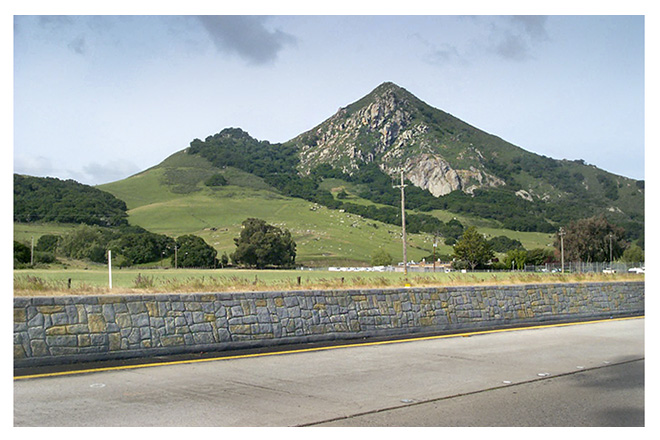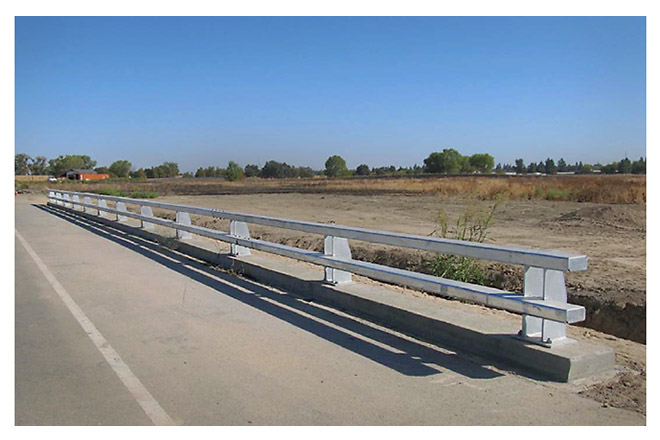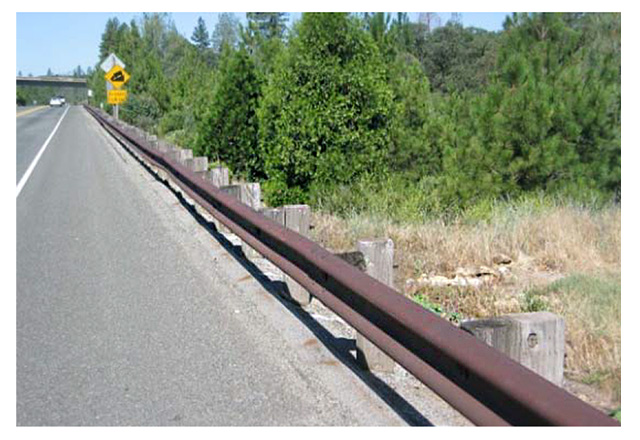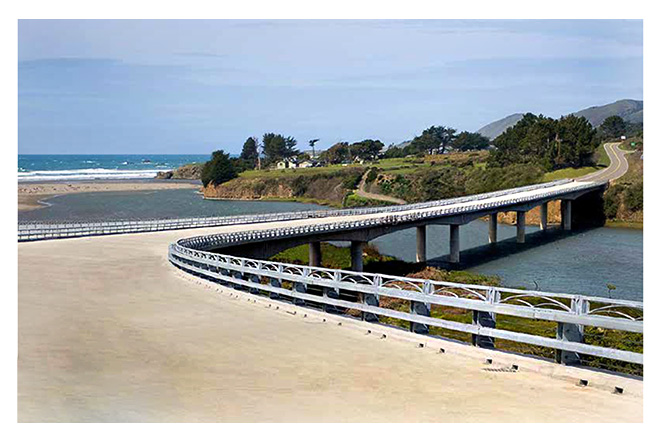Aesthetics

Photo of Aesthetic Visual Preservation: Landscape architects minimize visual impacts to California’s cultural and scenic resources. This cultural landscape is on Route 1 in Sonoma County.
Introduction
Aesthetics are considered in the planning and design process of all transportation projects to address visual quality, respond to community goals, and integrate transportation facilities into their context. Landscape architects are the departmental lead responsible for highway corridor aesthetics and are consulted early in the planning and design process to provide aesthetic reviews, aesthetic design expertise, and corridor master planning.
Many design approaches are used by landscape architects to address aesthetics, including, but not limited to:
- Locate highway alignments to be integrated into the surrounding topography.
- Preserve existing features such as vegetation, natural slopes, rock outcroppings, scenic views, historic and cultural resources, and sensitive environmental areas to the maximum extent feasible.
- Selectively thin or remove existing vegetation to open up scenic views.
- Replace highway planting and natural vegetation that is removed by construction activities.
- Grade embankment and excavation slopes to blend with natural contours and plant them to blend with the surrounding vegetation.
- Locate and design structures to give the most pleasing appearance and blend with the setting.
- Specify construction materials that reflect the local character.
- Incorporate design features that respond to community, cultural, scenic, and environmental values.
Aesthetic Concrete Barriers

Photo of Aesthetic Concrete Median Barrier near San Luis Obispo: Caltrans landscape architects met with the FHWA to identify a number of concrete barrier textures that meet Federal safety requirements yet also reflect the local visual context. The findings from these meetings are summarized in the California Highway Barrier Aesthetic Report posted below.
California Highway Barrier Aesthetics Report
Textured Barriers - Introduction (PDF)
Textured Barriers Final Report (Part 1) (PDF)
Textured Barriers Final Report (Part 2) (PDF)
Federal Concurrence Letter (PDF) Letter from the Federal Highway Administration to California Department of Transportation that approves the use of various textures and patterns on concrete highway barriers.
Barrier Fact Sheets, Reports, and Findings
Fact Sheet for Concrete Barrier Aesthetics (PDF) -
Information about texture, coloring, and innovative construction.
Caltrans First Textured Concrete Barrier - Stacked Stone Formliner (DOC) -
Information about California's first textured concrete barrier on State Route 1 in Carmel
Textured Concrete Barrier Type 60 - Random Stone Slip Form (PDF) -
Information about a slip form concrete barrier on State Route 1 in San Luis Obispo County
NCHRP Report 554 - Aesthetic Concrete Barrier Design (PDF) -
This report contains guidelines for aesthetic treatment of concrete safety shape barriers. The report will be of particular interest to design and safety practitioners with responsibility for roadside safety improvements.
Aesthetic Low Maintenance Guardrail

Photo of Aesthetic Low Maintenance Guardrail
This project was established to develop non‐proprietary, low-maintenance, aesthetically acceptable guardrail systems. The research in this project is divided into two tasks. The first task, which is summarized in this document, was to use an aesthetically pleasing bridge rail combined with a concrete footing as the guardrail system.
In addition to increasing the number of guardrail systems available, these low‐maintenance systems decrease the time the traveling public is subject to traffic delays during repairs. Low‐maintenance guardrail systems also lower the amount of time maintenance crews are at risk of injury when repairing damaged guardrail. This guardrail meets California's need for an aesthetically pleasing guardrail able to sustain vehicular impacts with minimal or no damage. The aesthetic element of the rail/footing combination provides local agencies with alternatives to traditional metal beam guardrailing.
Research Findings
Caltrans Division of Research and Innovation web page.
Development of Aesthetic, Low‐Maintenance Guardrail System Alternatives (PDF) . Crash testing of a bridge rail mounted onto a new concrete foundation design in an effort to provide aesthetic, low maintenance guardrail alternatives.
Aesthetic Low Profile Barrier
Photo of Aesthetic Low Profile Barrier
The purpose of this project is to develop an aesthetic low-profile barrier that could be used to shield motorists from trees or other landscaping obstacles, either in a median or on the right roadside.The total height of this barrier is 18 inches measured from the ground with posts spaced at 10 feet apart.
Research Findings
This research project is complete and now available online (PDF)
Type 732SW Bridge Rail

Photo of Type 732SW Bridge Rail
The Type 26 bridge rail is an existing cost effective barrier design that has been built on numerous bridges throughout the state. The bridge rail is a vertical, reinforced concrete wall on a sidewalk with a pedestrian steel tubular handrail or chain link fence on top and is usually constructed on routes with pedestrian walkways and posted speed limits of 45 mph or less. Although it is expected to meet safety requirements, it had never been crash tested. A crash-testing project for the Type 26 was initiated in the early 2000s but was modified to crash test the ST-20- bridge rail because of pending projects requiring see-through features. When the project was restarted, a taller, stronger, version of the Type 26 with a sidewalk was developed to be crash tested according the Manual for Assessing Safety Hardware (MASH) guidelines. This new version was named the Type 732SW.
Research Findings
Caltrans Division of Research and Innovation Report on the Type 732SW Bridge Rail
Weathering Steel Guardrail

Photo of Weathering Steel Guardrail
The objective of this problem focus study was to consider revising Traffic Operations Policy Directive 02-02 so that Weathering Steel Guardrail (WSGR) with an improved joint detail could be used in all regions of California except the three coastal regions identified on the Caltrans Pavement Climate Regions Map.
Research Findings
This research project is complete and is now available online (PDF)
Aesthetic Bridge Railing

Photo of Aesthetic Bridge Railing near Morro Bay
Bridge Rails and Barriers, A Reference Guide for Transportation Projects in the Coastal Zone (PDF) describes see-through vehicular bridge rails and barriers approved for use on bridges in California. Specifically, this document highlights bridge rails and barriers favored by the California Coastal Commission due to their aesthetic qualities and their ability to preserve scenic views. But note that these see-through bridge rails and barriers offer similar benefits beyond the Coastal Zone as well.
This document is a living document, and will be updated on a regular basis - demonstrating new barrier and rail types, additional pedestrian or bicycle rail attachments, and improved aesthetic features such as new colors and textures.
Another good reference for aesthetic bridge railings is the AASHTO Online Guide to Bridge Railings, published by the AASHTO-AGC-ARTBA Joint Committee Subcommittee on New Highway Materials.
Aesthetics Manuals and Guidance
To learn more about aesthetic considerations for transportation facilities see:
Design Information Bulletin (DIB) - 88 "Wall Structure Aesthetic Guidance"
Highway Design Manual Topic 109 (PDF), Scenic Values in Planning and Design.
Project Development Procedures Manual Chapter 29 (PDF), Section 6, Aesthetics.
Updated July 21, 2023

